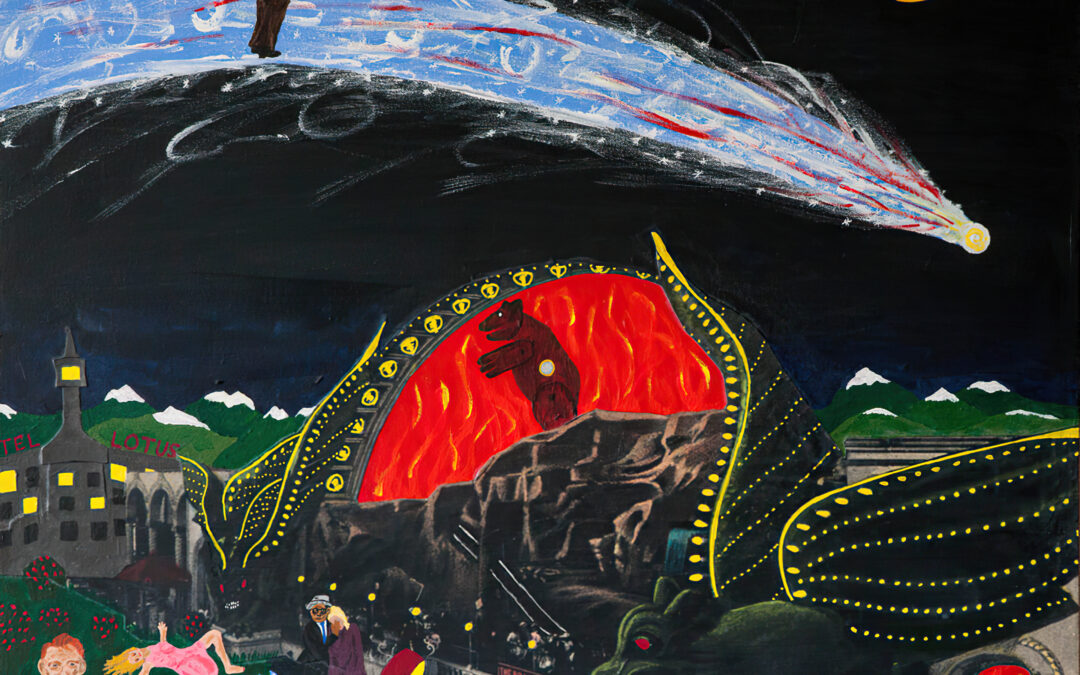(Len Jenkin, “Coming In On A Wing and a Prayer,” on loan from Linda Matney Gallery)
By Betsy DiJulio
The need to create has long been a fascinating, somewhat mysterious, aspect of human nature. Perhaps this drive is nowhere more evident than in the work of self-trained artists. Spark of Imagination, currently on view at the Muscarelle Museum of Art, explores the impulse to create through new acquisitions to their permanent collection as well as special loans. The work of American artists such as Clementine Hunter, Helen LaFrance, Grandma Moses, Sister Gertrude Morgan, and Matt Sesow present unique visual vocabularies along a spectrum of dynamic creative output.
In the following Q & A, Melissa Parris, Director of Collections and Exhibitions at the Muscarelle, shares some insight into why a visit to William & Mary this spring will likely prove fruitful.
Betsy DiJulio (BD): Melissa, what can visitors to this show expect to see in terms of numbers of pieces, subjects, and media?
Melissa Paris (MP): There are over 40 works by self-taught artists that range in era and geography as well as race and gender. The subject matter and media are as diverse as the artists in the exhibition. We have everything from a painted saw by Jacob Kass to vision boxes by Howard Finster. There are evangelizing works by Sister Gertrude Morgan and Leroy Almon. There are also US-themed works, including a Revolutionary War naval battle by early 20th-century artist J.O.J. Frost as well as commentary on September 11th by contemporary artist Matt Sesow.
BD: As diverse as the work is, what commonalities do you perceive in terms of style, theme, and the like?
MP: Each artist definitely has their own vision and style. The unifying factors of the exhibition are that the artists are all self-taught, American, and compelled to create. Stylistically you will see a number of artists making similar choices with flat pictorial space, irregular perspective, and scale. There are also artists like Mark Hopkins and Matt Sesow approaching their work through abstraction. A lot of the works in the exhibition are colorful and lively. Some other commonalities are that many of the artists had very long lives, started making art late in life, and many were also self-taught musicians.
BD: Will you share the scope of the Muscarelle’s collection, how this exhibition fits within it, and how the new acquisitions further the Muscarelle’s collecting vision?
MP: Since our founding in 1983, our collection has grown close to 7,000 works with a particular strength in prints and drawings from the 15th-21st century, primarily American and European. Self-taught art is a fairly new collecting area and is part of our strategic vision to add works by underrepresented artists.
BD: How were decisions made about what to borrow to show along with the new pieces owned by the museum?
MP: Our focus was on Virginia collections that featured self-taught art. The Taubman Museum of Art in Roanoke and the Colonial Williamsburg Foundation have wonderful collections and were so generous to lend. We are also are very lucky to have loans from the Baron and Ellin Gordon Collection, which includes exceptional works thoughtfully and passionately collected since the 1970s.
BD: Who has the enviable task of purchasing new work for the collection and what is the process by which those decisions are made?
MP: We have a restricted acquisitions fund that is solely for the purchase of art. It is a fairly formal process where we involve experts in the field and take things to the Museum’s Collections Committee. Periodically we refine our collecting rationale and goals to ensure that we ethically and safely steward art for the future.
BD: I know choosing a favorite artwork is akin to choosing a favorite child—or pet—but I’m going to ask you anyway: what is, we’ll say, one of your favorite pieces in the show and why does it especially appeal?
MP: Oh, that is a hard question! I will say that one of the most intriguing works in the exhibition is by Len Jenkin. As a professional writer and self-taught painter, Jenkin has weaved together a mysterious narrative that is not easily deciphered but well worth the investigation!
WANT TO SEE?
Spark of Imagination: The Spectrum of Creativity
Through April 10
Muscarelle Museum of Art @ College of William & Mary




